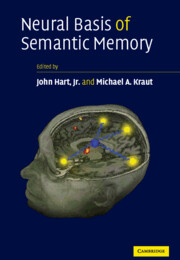Book contents
- Frontmatter
- Contents
- List of contributors
- Preface
- Part I Semantic Memory: Building Models from Lesions
- Part II Insights from Electrophysiology
- Part III Applications of Models to Understanding Cognitive Dysfunction
- Part IV Representations of Nouns and Verbs vs. Objects and Actions
- Part V Critical Role of Subcortical Nuclei in Semantic Functions
- Part VI Conceptual Models of Semantics
- Part 10 Process and content in semantic memory
- 11 The conceptual structure account: A cognitive model of semantic memory and its neural instantiation
- 12 Neural foundations for conceptual representations: Evidence from functional brain imaging
- 13 Neural hybrid model of semantic object memory (version 1.1)
- Index
- References
12 - Neural foundations for conceptual representations: Evidence from functional brain imaging
from Part VI - Conceptual Models of Semantics
Published online by Cambridge University Press: 14 September 2009
- Frontmatter
- Contents
- List of contributors
- Preface
- Part I Semantic Memory: Building Models from Lesions
- Part II Insights from Electrophysiology
- Part III Applications of Models to Understanding Cognitive Dysfunction
- Part IV Representations of Nouns and Verbs vs. Objects and Actions
- Part V Critical Role of Subcortical Nuclei in Semantic Functions
- Part VI Conceptual Models of Semantics
- Part 10 Process and content in semantic memory
- 11 The conceptual structure account: A cognitive model of semantic memory and its neural instantiation
- 12 Neural foundations for conceptual representations: Evidence from functional brain imaging
- 13 Neural hybrid model of semantic object memory (version 1.1)
- Index
- References
Summary
Overview
Semantic memory refers to a major division of declarative memory that includes knowledge of the meaning of objects and words. This chapter will focus on one aspect of the functional neuroanatomy of semantic memory: the representation of the meaning of concrete objects and object properties. The initial motivation for our work on this topic was reports of patients with so-called category-specific knowledge disorders – specifically, patients with relatively selective impaired knowledge about animals and other animate objects, and those with relatively selective impairments for man-made, inanimate objects such as tools. Since the publication of the seminal case studies by Warrington and colleagues (Warrington & McCarthy, 1983; Warrington & Shallice, 1984), well over 100 patients have been reported with a category-specific deficit for biological categories (living things, especially four-legged animals), relative to inanimate objects (especially tools and other artifacts), and more than 25 cases with the opposite pattern of deficit (Capitani et al., 2003). Our work has been motivated by an appreciation of the importance of these clinical cases for understanding the organization of conceptual knowledge, object recognition, and storage of long-term memories. In this chapter I shall outline a model of how conceptual knowledge about concrete entities (objects) is organized in the brain based on functional brain imaging studies of normal, intact individuals. From a theoretical perspective, the model attempts to incorporate the main features of property-based models that have dominated thinking about category-specific disorders for over one hundred years, and the challenge to this view from the Domain Specific theory (Caramazza & Shelton, 1998; for an overview of recent theories of the organization of conceptual knowledge in the brain see Caramazza, 1998; Martin & Caramazza, 2003).
Keywords
- Type
- Chapter
- Information
- Neural Basis of Semantic Memory , pp. 302 - 330Publisher: Cambridge University PressPrint publication year: 2007
References
- 6
- Cited by

